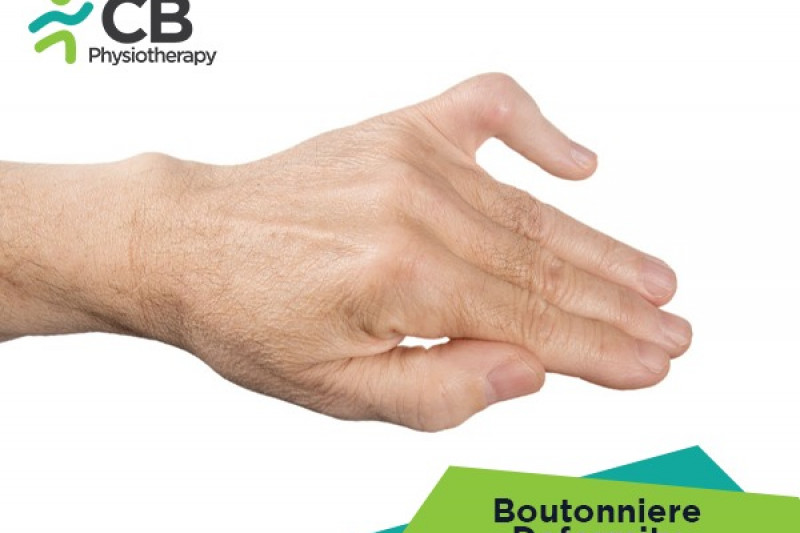
Boutonniere Deformity or central slip injury is a deformity of the fingers or toes in which the proximal interphalangeal joint is flexed and the distal interphalangeal joint is hyper-extended, this results in an inability to straighten that particular finger joint and is also difficult to bend.
A boutonniere deformity can happen for several reasons:
Symptoms of boutonnière deformity can develop immediately after an injury or might develop after a week to 3 weeks:
Pathology
Boutonniere’ deformity results when the central slip of the tendon is disrupted. This disruption of the tendon causes the lateral bands to displace volarly. This results in forced flexion of the finger which causes limitation of the DIP joint to extend. It can be secondary to rheumatoid arthritis (RA) or a burn injury. In the case of inflammatory arthritides such as RA, inflammatory cells collect in the synovial fluid of the joint and form a layer of fibrous tissue which leads to bony erosion resulting in damage of cartilage and ligaments. This causes the joints to gradually deform leading to loss of function and pain.
X-rays
X-rays are required to see if there is an avulsion fracture.
Treatment options include both surgical and nonsurgical modalities. After surgery, a splint or brace for several weeks is used to keep the proximal interphalangeal joint straight, physiotherapy often follows splinting. Splinting is also a non-surgical treatment used for immobilization followed by exercises to improve the strength and flexibility of the affected digit. The goal of physiotherapy treatment is to regain the full range of motion and strength of the affected finger. If the injury occurs as a result of sports then the affected area may be splinted or taped for protection during activity.
Medicine: Non-steroidal anti-inflammatory medications (NSAIDs), Disease-modifying anti-rheumatic drugs (DMARDs), glucocorticoids, analgesics, etc.
NOTE: The medication should not be taken without the doctor's permission.
Immobilization
For the injury which occurs to the central slip due to a simple avulsion of the tendon from the bone, splinting of the PIP joint is recommended for 6 weeks after that, the splint needs to be worn at the night for a few weeks. The splint allows movement to the DIP joint and thus exercises can be done to prevent stiffness. Some splints are similar to springs and can be used to gently stretch the PIP joint for several weeks to prevent the formation of contracture. The spring applies continuous gentle pressure, helping to straighten the PIP joint slowly.
The physiotherapist recommends exercises designed to get the hand and fingers working so that the work tasks and daily activities can be done easily. They also guide to help find ways to do tasks in such a way that don't put too much stress on the finger joint.
Range-of-motion exercise.
Gentle range-of-motion exercises can help to retain the range of motion, flexibility, and mobility.
Strengthening exercises
Strengthening exercises usually follow 8 to 10 weeks after surgery range of motion exercises can be recommended with resistance like squeeze –ball, gel balls, etc.
Stretching exercises
Stretching exercises are done at PIP contracture before repairing or reconstruction. Stretching exercises are done to improve the strength and flexibility of the fingers.
MCPJ flexion and extension
Bend the fingers from the knuckles, make sure to keep the fingers straight. Hold this position for 5 secs and then straighten. Repeat this 10 times and do it 1-2 hrs.
DIPJ flexion and extension
Bend the tip of the finger over the edge of the splint and hold for 5 seconds, straighten the fingertip and hold for 5 seconds. With the other hand hold the splint and keep the joint that has been splinted, straight. Repeat this 10 times and do it for 1-2 hours.
PIPJ flexion and extension
Bend the finger at the middle joint, while wearing the splint, and allow the splint to return the finger to a straight position. Repeat 10 times and do it for 1-2 hours.
Pain can be reduced and function can be improved by surgery but might not be able to correct the condition fully. The deformity if left untreated for more than 3 weeks, then it can become much more difficult to treat.
Select your City to find & connect with our experts regarding Physiotherapy for Boutonniere Deformity